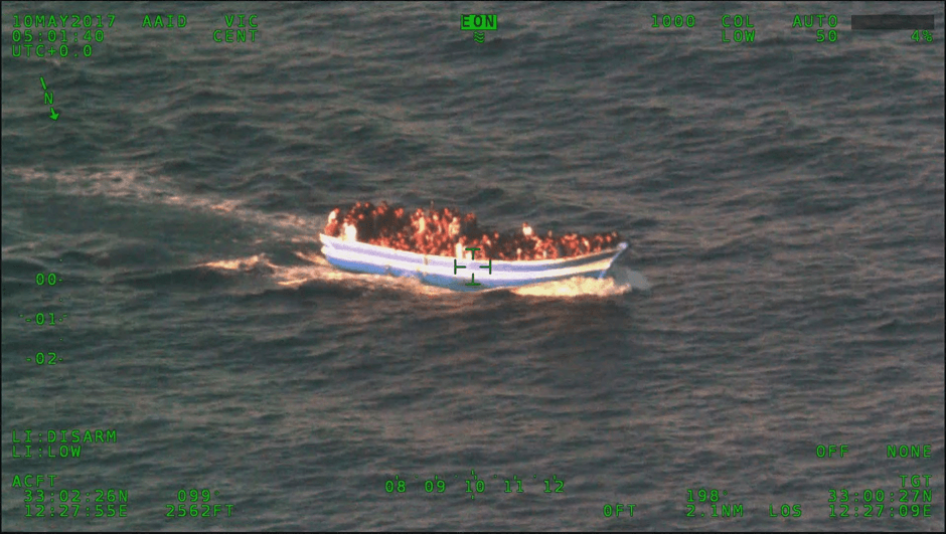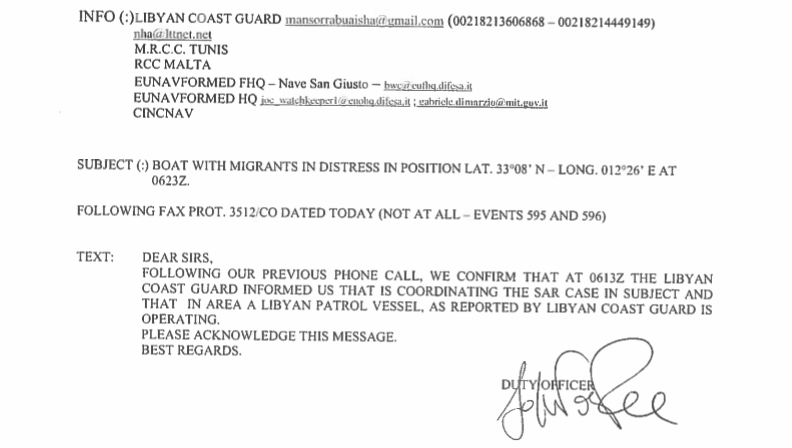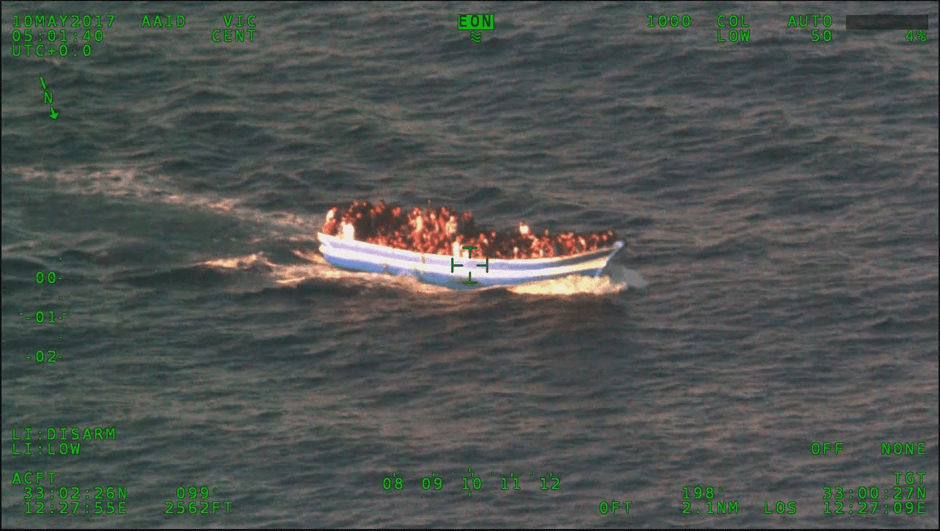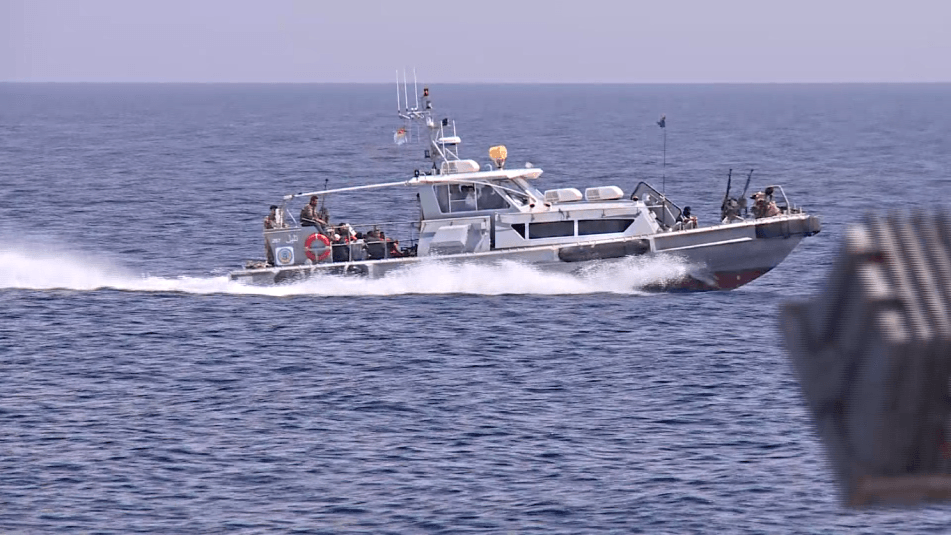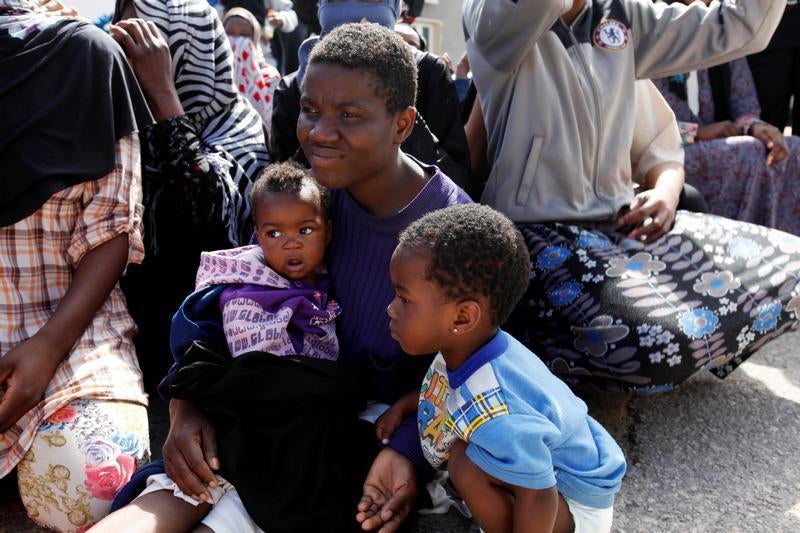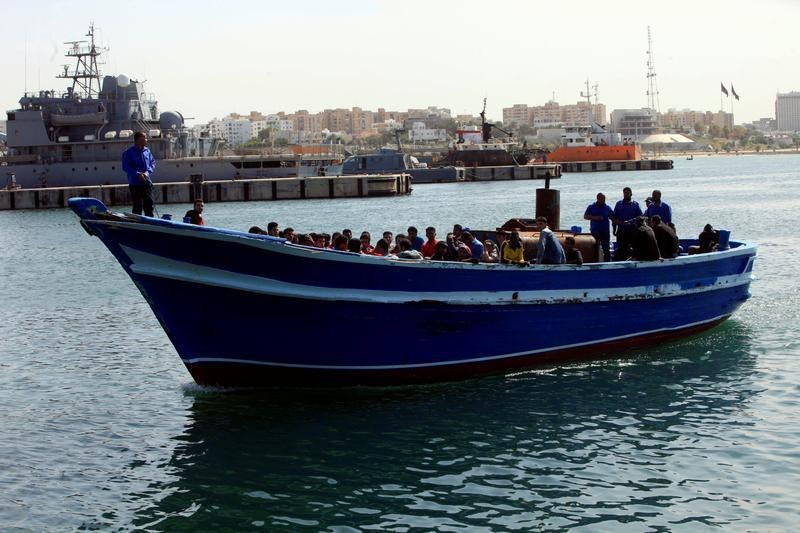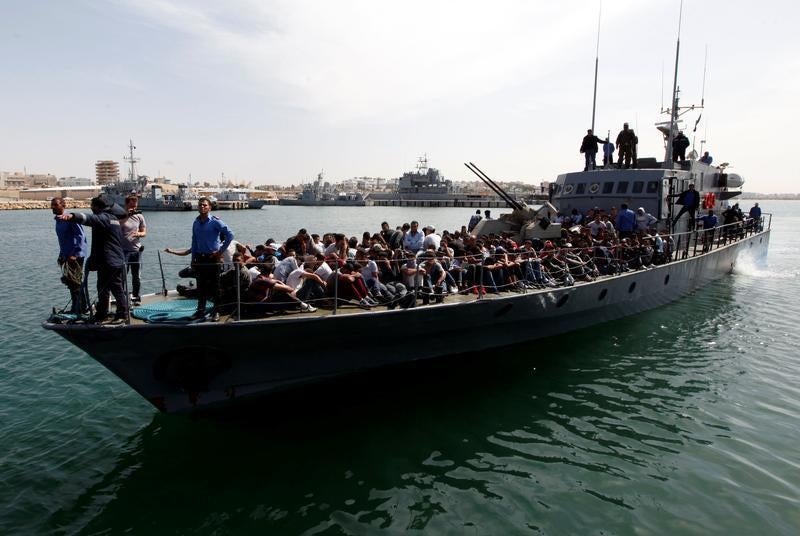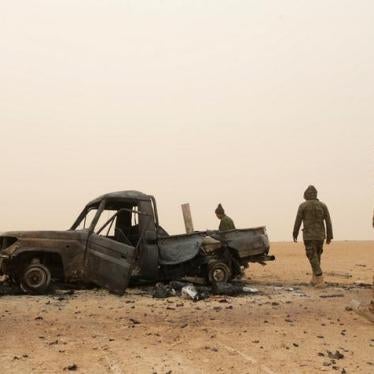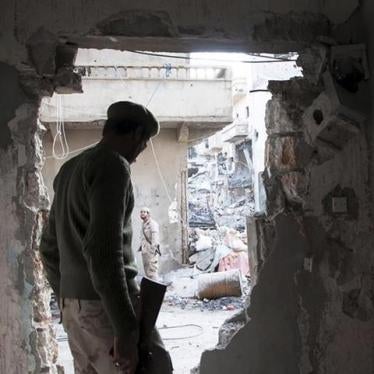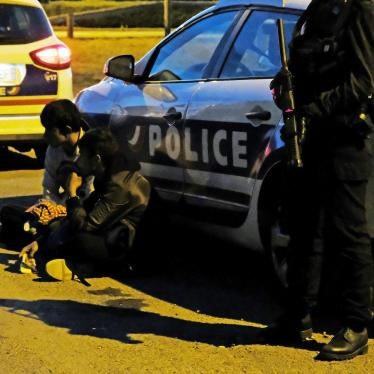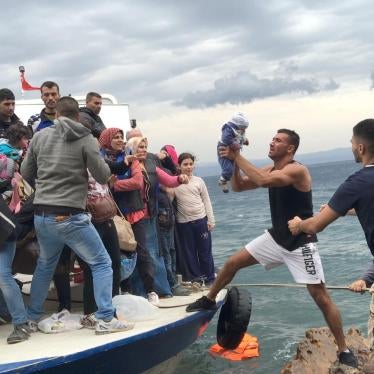(Milan) – Libyan forces have engaged in reckless conduct during recent rescue operations that endangered people being rescued in international waters in the Mediterranean, Human Rights Watch said today. These incidents indicate that Libyan forces lack capacity to safely perform search-and-rescue obligations.
Italy and other European Union countries should not cede control over rescue operations in international waters to Libyan forces. During the European Council meeting in Brussels on June 22-23, 2017, EU member states should affirm a commitment to carry out search-and-rescue operations in the central Mediterranean.
“Recent incidents show how wrong it is for EU countries to entrust the lives of those in need of rescue to Libyan coast guard forces when there are safer alternatives,” said Judith Sunderland, associate Europe and Central Asia director at Human Rights Watch. “The EU should ensure that its vessels carry out robust search-and-rescue operations in international waters close to Libya, where most shipwrecks occur, and, where possible, Italy should direct vessels from the EU and nongovernmental groups to take the lead on rescues, instead of Libyan vessels.”
The central Mediterranean is the deadliest migration route in the world. From the beginning of 2014 through June 1, 2017, over 12,000 people have died or been reported missing. Since January 1, over 60,000 people have been rescued and brought to Italian shores.
On May 10 and May 23, Libyan coast guard forces’ patrol boats in international waters intervened in rescues already in progress by nongovernmental organizations, used threatening behavior likely to induce panic, and failed to provide life jackets to people seeking rescue from unseaworthy vessels. On May 23, nongovernmental groups witnessed – and videotaped – Libyan coast guard officers firing shots into the air, and collected corroborating testimony from survivors that the officers had also fired shots into the water after panicked people had leapt into the sea.
Italy’s decision to cede control of the May 10 event to Libyan coast guard forces was consistent with an overall EU strategy to deputize Libyan authorities to prevent boat migration to Europe despite deep concerns about outsourcing responsibility to one party in a country riven by conflict and where migrants face horrific abuse, Human Rights Watch said.
There are credible reports from monitors on the scene that on May 26, a Libyan coast guard forces boat fired shots at an Italian coast guard vessel in international waters, as it was taking rescued migrants to disembark on Lampedusa. The incident was reported in the Italian media, although the Italian coast guard has denied knowledge of the incident. Human Rights Watch spoke with a person who was on a vessel in the Mediterranean that day who overheard radio communication on an open channel between a nearby Italian Navy ship and the Libyan coast guard forces vessel. The radio communication made it clear that the Libyan coast guard forces boat had fired the shots because they mistook the Italian coast guard vessel for a migrant boat.
As a general rule, Libyan forces disembark people they rescue or intercept at sea in Libya, where they face arbitrary detention in abysmal conditions and a well-documented risk of serious abuse, including forced labor, torture, and sexual violence. Due to what the United Nations has called a “human rights crisis” for migrants in Libya, EU-flagged vessels are prohibited from returning anyone there, regardless of where a rescue takes place. The UN refugee agency, UNHCR, has called on all countries to “allow civilians fleeing Libya (Libyan nationals, habitual residents of Libya, and third country nationals) access to their territories.”
On May 10, the Italian Maritime Rescue Coordination Center (MRCC) in Rome received the first distress call about a boat in trouble and ordered the German group Sea-Watch to provide assistance but then allowed Libyan coast guard forces to assume coordination and a Libyan patrol boat to take over the operation. Although MRCC Rome learned of the boat when it was still in Libyan territorial waters, the incident occurred roughly 20 nautical miles from the Libyan coast, in international waters, and Sea-Watch had already begun its rescue operation.
Libyan authorities lack the capacity, equipment, and training to perform safe rescues, which should be required before they can assume coordination, Human Rights Watch said. If Italy is directing a rescue operation, it should ensure safe rescue and disembarkation, and not hand over command to Libyan coast guard forces, except in situations of imminent loss of life and the absence of alternate rescue vessels.
The commander of the coast guard force aligned with the EU-recognized Libyan Government of National Accord, operating under the Defense Ministry, in Zawiyah, a coastal town 50 kilometers west of Tripoli, told Human Rights Watch during its visit in April that the use of force against migrants, and specifically beatings with plastic pipes, during rescue operations was “necessary to control the situation as you cannot communicate with them. Some can swim but others not.”
Libya has never officially delineated its search-and-rescue zone or provided the International Maritime Organization with information on these services even under Muammar Gaddafi. Since at least October 2013, when it began its massive humanitarian naval operation, Mare Nostrum, Italy has assumed de facto search-and-rescue responsibilities outside Libyan territorial waters.
Italy and EU countries with these responsibilities in the Mediterranean, notably Malta, have an obligation under international maritime law to maintain an effective search-and-rescue service that ensures both safe rescue operations and disembarkation in a place of safety. In doing so, they should consider whether any of their actions may place rescued people at risk of persecution, torture, or cruel, inhuman, or degrading treatment upon disembarkation.
To fulfill these obligations, EU states should at a minimum decide during the summit to design and maintain a system under which they assume and retain command over all rescue operations in international waters. They should also renew efforts to obtain permission to operate in Libyan waters so that EU-flagged vessels can be in a better position to perform rescues.
EU institutions should ensure monitoring of training for Libyan coast guard officers as well as Libyans’ use of equipment provided by EU countries, and be prepared to suspend equipment transfers in the event a link is established between such equipment and abuse. Until there are demonstrable improvements in the treatment of detainees in Libya’s migrant detention centers and in Libyan coast guard custody, EU countries should take every measure to avoid complicity in abuse both at sea and on land by Libyan authorities. All efforts to improve conditions in official detention centers in Libya should be accompanied by monitoring, transparent public reporting, and measures to ensure accountability. Training modules should prioritize hands-on practical training in best practices for safe search-and-rescue operations.
EU member states should also take account of an arms embargo imposed by the UN Security Council against Libyan factions, which stipulates how delivering nonlethal materials and training should be handled. On June 10, the Libya Sanctions Committee tasked with overseeing implementation of the arms embargo issued a report in which it raised concerns about whether the beneficiaries of EU training fall within permissible exemptions to the embargo, taking into consideration among other factors questions around effective control of the coast guard forces and vetting of training participants.
“No amount of wishful thinking can justify ignoring the limitations of Libyan authorities to respond to situations of distress at sea or to intervene in a safe and humane way,” Sunderland said. “If EU governments care about saving lives and preventing abuse of migrants in Libya, they should provide more support for vital EU rescue operations in the Mediterranean rather than putting their faith in unreliable Libyan partners.”
EU Migration Cooperation with Libya
Armed conflicts since 2014 in Libya have resulted in a humanitarian and governance crisis, with a quarter million Libyans displaced and a breakdown in the economic, political, and judicial systems. The country has three rival authorities competing for legitimacy, international recognition, and territorial control: a UN-backed and EU-recognized Government of National Accord (GNA), based in Tripoli; the Government of National Salvation, also based in Tripoli; and the Interim Government, based in the eastern cities of al-Bayda and Tobruk. The GNA has limited control over key institutions and only nominal control over forces aligned with them.
The evidence of brutality against migrants in Libya is overwhelming. A damning December 2016 report from the Office of the High Commissioner for Human Rights and the UN mission in Libya documented widespread malnutrition, forced labor, illness, beatings, sexual abuse, torture, and other abuses in immigration detention centers in Libya. A German Foreign Ministry memo leaked to the media in January 2017 stated that migrants in Libya are executed, tortured, raped, extorted, and banished to the desert “on a daily basis.” Human Rights Watch has documented abuses against migrants in Libya for years, including by guards in detention centers under the Directorate for Illegal Migration (DCIM), Libyan coast guard forces, and smugglers.
The GNA Interior Ministry operates about 24 “official” detention facilities for migrants in western Libya that are at least nominally under ministry control. Militias and criminal gangs detain migrants in parallel, unofficial centers.
The EU’s anti-smuggling operation EUNAVFOR MED – also known as Operation Sophia – began training Libyan Navy coast guard officers, petty officers, and seamen under the GNA’s Defense Ministry in October 2016. Ninety-three officers participated in training aboard EU navy ships in the Mediterranean, while 42 have been trained in Malta and Greece in training programs on land that will continue in Spain and Italy through the end of 2017. The planned third phase, which has not begun, would involve training on board Libyan patrol boats in Libyan territorial waters. In the February 2017 Malta Declaration, EU countries pledged to prioritize “training, equipment and support” to the Libyan coast guard forces, as well as “enhanced operational action” to shut down the central Mediterranean route. Also in February, Italy signed a Memorandum of Understanding with the GNA, which was suspended by a court in Tripoli in March, and began in May to deliver the first 4 of 10 patrol boats to Libyan coast guard forces.
Since at least October 2013, Italy has coordinated virtually all rescue operations by the Italian coast guard and Navy; the EU border agency, commonly known as Frontex; Operation Sophia; and vessels from nongovernmental groups, as well as commercial ships when necessary. Nine groups – Migrant Offshore Aid Station (MOAS), Médecins sans Frontières (MSF), SOS MEDITERRANEE, Sea-Watch, Jugend Rettet, Sea Eye, Life Boat Minden, Proactiva Open Arms, and Save The Children – have dedicated rescue patrols in the central Mediterranean. According to Italian government figures, nongovernmental groups rescued one-quarter of all those rescued in 2016, and one-third of those rescued in the first three months of 2017.
Just as the Libyan government is fragmented, so too are Libyan coast guard forces. The EU support is directed to Navy coast guard forces in western Libya, which operate at least nominally under the GNA Defense Ministry. The commander of the coast guard forces in Zawiyah told Human Rights Watch during the April visit that the GNA coast guard chief had only nominal control over forces in different points in western Libya – including in the towns and cities of Misrata, Tripoli, Zawiyah, Sebratha, and Zuwara.
The GNA Interior Ministry also has its own Coastal Security forces. Col. Tariq Shanbour, head of the Interior Ministry’s Coastal Security forces and based in Tripoli, told Human Rights Watch during its visit that although his forces had no rescue boats, their mandate extended from operations on land and through the Libyan territorial waters, up to 12 nautical miles. Colonel Shanbour said his forces combat crime, including irregular migration, fuel smuggling, illegal fishing, and drug trafficking.
In April, the European Commission announced a €90 million aid program for migrants in Libya, about half of which would go to improving conditions in official detention centers, assistance at disembarkation points, and voluntary returns, among other measures.
The May 23 Incident
Human Rights Watch’s understanding of what happened on May 23 is based on a detailed incident report provided by MSF; phone interviews with an MSF crew member and a crew member from the German group Jugend Rettet, who witnessed the incident; and public statements by other groups on the scene. All times for both incidents are in Coordinated Universal Time (UTC), which is two hours behind Central European Time (CET).
On May 23, a Libyan coast guard patrol boat intervened in a rescue operation already in progress in international waters by the Aquarius, a rescue ship jointly operated by MSF and SOS Mediterranée, and the Iuventa, a vessel operated by Jugend Rettet.
After an EUNAVFOR MED plane spotted 8 to 10 migrant boats at 06:50, the Italian MRCC in Rome appointed the Vos Hestia, a rescue vessel operated by Save The Children, as on-scene commander.
By 08:30 the Aquarius had reached the area, 15 nautical miles from the Libyan coast in international waters, and began its rescue operation. By noon, its crew had distributed life jackets to people on board a white rubber boat and evacuated 34 people before having to order its speedboats to attend to another boat in a more serious distress situation. At 10:30, a Libyan coast guard patrol boat with the number 267 entered the rescue area and approached several of the migrant boats, creating destabilizing waves.
A Jugend Rettet crew member, who was on a RHIB – a rigid-hulled inflatable boat – distributing life jackets at the time, said the patrol boat approached them at one point: “We have standing orders to be cooperative, and we thought they might want to help. We waved, they waved back, even gave us the thumbs up. We thought everything was ok.”
The Libyan patrol boat retreated to a distance. Crew aboard the Aquarius heard at least six shots fired into the air from machine guns mounted on the Libyan patrol boat. The Libyan patrol boat then steered back toward the migrant boats, and at around 13:00, two men on the Libyan patrol boat, one of whom was in uniform and armed with an AK-47 assault rifle, boarded one of the migrant boats, a white rubber boat, and began steering it toward Libyan territorial waters.
A photograph posted by Jugend Rettet shows one of the Libyan coast guard members pointing the assault rifle at the people on board, and footage from an Italian television crew aboard the Aquarius shows the same man firing two or three shots into the air. The footage also shows dozens of panicked people jumping into the water.
Testimony gathered by MSF from survivors would later allege that the Libyan officers had taken their phones and money, even a man’s ring. As the Libyan officers steered the white rubber boat back toward Libya, more people jumped into the water. The Aquarius crew eventually pulled 67 people from the water. At 13:40, the Libyan officers changed course and steered the rubber boat toward the Aquarius, and at 14:00, they said they wanted to hand over the people on board. By 14:17, all 38 people who had remained on the white rubber boat had been transferred to the Aquarius RHIB.
While two of its crew had boarded the rubber boat, the Libyan patrol boat had remained alongside a wooden boat crowded with migrants, which it would eventually steer back to Libya, and transferred dozens from a second wooden boat to the patrol boat. Nongovernmental groups estimate that between 200 and 400 people were taken back to Libya. Their vessels rescued 11 migrant boats.
MSF collected testimony from two men, one who said he was Libyan and another who said he was Syrian, who were pulled out of the water after they jumped off the wooden boat. The men alleged that coast guard officers also took money and phones from passengers on the wooden boat.
Corroborating testimony collected by MSF among survivors on their rescue ship suggests that the Libyan coast guard forces fired more shots than logged by the nongovernmental vessels in the area. Most worrisome, six people who had jumped into the water from the rubber boat and two men who jumped from the wooden boat alleged that Libyan officers had fired shots into the water after people jumped. No corpses were found, nor did anyone rescued have fresh gunshot wounds.
A Libyan Navy spokesman, Admiral Ayyoub Amr Qassem, denied some aspects of the nongovernmental groups’ version of events, arguing it was “illogical” for the Libyan coast guard to shoot at migrants.
The May 10 Incident
The Human Rights Watch understanding of the event is based on the Sea-Watch ship’s log, a phone interview with a Sea-Watch crew member who witnessed the incident, email communications between the Italian Maritime Rescue Coordination Center (MRCC) provided by Sea-Watch, and statements by the Italian MRCC and the Libyan Navy coast guard.
On May 10, the Italian MRCC in Rome allowed a Libyan coast guard vessel to assume coordination over a rescue operation in international waters. Sea-Watch, which had already begun its rescue operation on previous instructions from MRCC Rome, filmed the Libyan patrol boat conducting a dangerous maneuver, creating a risk of collision, and has called for an independent investigation.
At 05:38 UTC, MRCC Rome called the German Sea-Watch 2 ship to inform it of a migrant boat at position 33° 00’N, 012° 27’E, which is within Libyan territorial waters. The coordination center followed up with an email stamped 05:42 instructing Sea-Watch to “please divert your course…and provide assistance” to the migrant boat.
At 06:25, when the Sea-Watch ship sighted the migrant boat – a severely crowded wooden boat carrying almost 500 people – they were at position 33° 08.9’N, 012° 28.9’E. This is approximately 20 nautical miles from the Libyan coast, in international waters.
MRCC Rome called the Sea-Watch ship at 06:47 asking it to “confirm target boat,” and sent an email 11 minutes later, at 06:58, with a photo of the boat time-stamped 05:01. Sea-Watch initiated its rescue operation, lowering a speedboat loaded with life jackets to approach the migrant boat. But at 06:56, MRCC Rome called Sea-Watch to tell them that Libya was taking over coordination of the rescue operation, and sent an email indicating that, “Following our previous phone call, we confirm that at ‘06:13Z’ [the Z indicates UTC time zone], the Libyan Coast Guard informed us that it is coordinating the SAR case in subject and that a Libyan patrol vessel, as reported by Libyan Coast Guard, is operating.”
The Sea-Watch log indicates that its speedboat was in the water at 06:59. The boat approached the migrant boat, and the ship’s log indicates that it made contact at 07:04. During this time lapse, Sea-Watch attempted repeatedly to reach the Libyan patrol boat, which the crew could see approaching at a fast clip, by radio on numerous frequencies; they received no response. Sea-Watch told Human Rights Watch that, “Of course we would proceed with [the speedboat operation], as we thought also with a coordination through the Libyans, the speedboats would be needed in the water at least on standby to guarantee a safe disembarkation.”
The Sea-Watch ship’s log reports at 07:04, as the speedboat was engaging in shouted conversation with migrants aboard the wooden boat, the Libyan patrol boat 206 crossed their bow, in what Sea-Watch said was a dangerous maneuver. Sea-Watch reports that the Libyan patrol boat did not respond to radio calls from the German ship. The Sea-Watch speedboat returned to the group’s larger vessel, and the Libyan coast guard boat proceeded to transfer several hundred people from the wooden boat to their own boat. At least two officers boarded the wooden boat, with numerous people still on board, to steer it back to land. No one was provided life jackets, putting them at risk.
According to the UN Refugee Agency, UNHCR, 484 people disembarked in Tripoli, including 14 women and 19 children. The rest were adult men. Four women were hospitalized – it is unclear why – while the rest were detained at the Mitiga airbase in Tripoli.
The Libyan Navy spokesman, Admiral Qassem, alleged that Sea-Watch “tried to hinder the work of our coast guard to take the migrants.” The GNA’s Libyan coast guard did not respond to email queries and phone calls. In an email to Human Rights Watch, the Italian coast guard said that “MRCC Rome, as the first Maritime Rescue Coordination center that received the information, according to SAR international procedures, informed the Coastal state’s SAR authorities in whose territorial waters was the boat in distress and contacted the nearest known ship, M/V SEA WATCH 2… later, MRCC Rome informed M/V SEA WATCH 2 that the Libyan Coast Guard had assumed the coordination of the SAR case.”
Captain Sergio Liardi, head of MRCC Rome, told Human Rights Watch that alerting Libyan authorities in this case was appropriate, as he had to do everything possible to prevent loss of life. Human Rights Watch does not dispute that saving lives should be the guiding priority, but questions why it was necessary for the Italian coast guard to allow Libyan coast guard forces to assume control over a rescue operation in international waters that Sea-Watch had already commenced and was better equipped to perform safely.
Law and Practice on Rescue at Sea
Coastal states have different sovereign, jurisdictional, and search-and-rescue rights and obligations depending on the maritime zone. Territorial waters, which extend 12 nautical miles from the coast, are considered national territory where governments exercise full sovereign rights. In other words, a boat in Libyan territorial waters has not legally left Libyan territory; in legal terms, the return of passengers on a boat in territorial waters to land is simply a transfer from one part of the national territory to another. The contiguous zone is the area adjacent to territorial waters, for a maximum of 24 nautical miles from the coast, where a coastal state enjoys certain jurisdictional rights to prevent and punish infringements of its laws, including immigration laws. Finally, all coastal states should have designated search-and-rescue (SAR) zones, where under international law they are required to coordinate and perform rescue operations.
Libyan authorities are legally entitled to enforce their immigration laws in Libyan territorial waters, and to punish infringements of its immigration laws in the contiguous zone. This means Libyan authorities have jurisdiction to interdict migrant boats in the contiguous zone even in the absence of a distress situation. Libya is also a party to UN protocols against smuggling and trafficking of human beings.
The UN Protocol against the Smuggling of Migrants by Land, Sea and Air stipulates that interdictions at sea based on suspicion of people smuggling must ensure the safety and humane treatment of the persons on board, and must “preserve and protect the rights of [smuggled] persons…in particular the right to life and the right not to be subjected to torture or other cruel, inhuman or degrading treatment or punishment.” The protocol further requires Libya to take measures to protect smuggled migrants from violence, and to take special account of the needs of women and children. The UN Protocol to Prevent, Suppress and Punish Trafficking in Persons, Especially Women and Children requires Libya to put in place measures to assist and protect trafficking victims.
Libyan law criminalizes undocumented entry, exit, and stay in Libya, punishable by imprisonment, and in some cases with forced labor or a fine. Libyan immigration law does not distinguish between migrants, refugees, asylum seekers, victims of trafficking, or other particularly vulnerable groups. Libya has not ratified the 1951 Refugee Convention. Human Rights Watch, Amnesty International, and the UN Office of the High Commissioner for Human Rights and the UN Support Mission in Libya, among others, have documented abuses by the Libyan coast guard forces during interdictions and arbitrary detention, torture, sexual violence, and other gross human rights abuses upon return to Libya.
The laws of the sea have developed to try to ensure effective and timely assistance to any vessel in distress. The UN Convention on the Law of the Sea (UNCLOS) and the International Convention for the Safety of Life at Sea (SOLAS) require that all coastal states “promote the establishment, operation and maintenance of an adequate and effective search-and-rescue service regarding safety on and over the sea and, where circumstances so require, by way of mutual regional arrangements co-operate with neighbouring States for this purpose.” SOLAS stipulates that the country in whose search-and-rescue zone a distress situation occurs has the “primary responsibility” for coordination and cooperation so that assisted people disembark in a place of safety. The International Maritime Search and Rescue Convention does not resolve the issue of responsibility when a coastal state party to the convention, like Libya, cannot or does not fulfil its obligations, but it also stresses regional cooperation.
International maritime law imposes a clear duty on all vessels at sea to rescue people in distress, whether in territorial or international waters. This means that ships may enter Libyan territorial waters without authorization to respond to a situation posing a threat of imminent loss of life. In the event of a sighting of a vessel in territorial waters showing signs of distress, but in the absence of imminent danger, any vessel in the area will normally monitor the situation until forces under the command of the sovereign nation arrive to provide assistance.
For years, Libya has largely failed to live up to its search-and-rescue obligations. It has never officially delineated its search-and-rescue zone or deposited information about its search-and-rescue services with the International Maritime Organization (IMO). Libya does not have a fully functioning MRCC. The Italian government assumed de facto control over search-and-rescue off the Libyan coast when it began its massive year-long humanitarian operation Mare Nostrum in October 2013. It has continued since then to coordinate virtually all rescue operations by Frontex, Operation Sophia, and nongovernmental groups vessels, as well as commercial ships when necessary.
This is in keeping with IMO Maritime Safety Committee guidelines on the treatment of people rescued at sea, which clarify that every MRCC should have “effective plans” to respond to all types of search-and-rescue situations, including incidents outside its own search-and-rescue region “until the RCC [rescue coordination center] responsible for the region in which assistance is rendered…or another RCC better situated to handle the case accept responsibility.” These guidelines stipulate that a “place of safety” for disembarkation involves, at a minimum, a place where the survivors’ “safety of life is no longer threatened and where their basic human needs (such as food, shelter and medical needs) can be met.” They also set out a variety of additional factors to be considered when designating a “place of safety,” including, in the case of asylum seekers and refugees recovered at sea, “the need to avoid disembarkation in territories where the lives and freedoms of those alleging a well-founded fear of persecution would be threatened.”
While the guidelines provide the most authoritative source on the concept of a “place of safety” in maritime law, Human Rights Watch believes the concept can only be interpreted in light of other international obligations, including the absolute prohibition of the return of any person to the risk of torture, and protections against cruel, inhuman, or degrading treatment and arbitrary detention. Given the mixed profiles of people trying to reach Europe by sea, there should be a presumption that among those rescued there may be people who are unable to exercise their right to seek asylum while in Libya and need international protection.
UNHCR has also provided guidance that interception measures at sea should not de facto deny access to international protection or lead to anyone “being returned, directly or indirectly, to…territories where their life or freedom would be threatened.” In a 2012 landmark ruling, the European Court of Human Rights condemned Italy for pushbacks to Libya in 2009, a policy that included cases in which Italy forcibly transferred rescued people to Libyan vessels at sea.
Italian and EU authorities have repeatedly emphasized that these operations are governed by international law and EU jurisprudence that prohibit returning anyone to a place where their lives or safety would be at risk – the nonrefoulement principle. In practice, this means that no one rescued by an EU-flagged ship or under the custody or control of an EU member state can be sent back to Libya, regardless of the waters in which that person was rescued or interdicted.
Given the lack of capacity to carry out safe rescues, the Italian MRCC and EU authorities should not allow the Libyan coast guard forces to assume operational command of rescue operations in international waters. In addition, the real risk of prohibited ill-treatment in Libya for any migrant returned there means anyone rescued by an international vessel should not be disembarked in Libya.
Until Libyan authorities end arbitrary detention and demonstrate sustained and significant improvements in conditions and treatment in detention centers to remove a real risk of survivors facing treatment that violates the European Convention on Human Rights, EU authorities should not cede its search-and-rescue responsibilities to Libyan coast guard forces.
